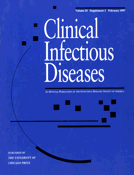-
PDF
- Split View
-
Views
-
Cite
Cite
Heike von Baum, Joachim Schehl, Heinrich K. Geiss, Franz Schaefer, Prevalence of Vancomycin-Resistant Enterococci Among Children with End-Stage Renal Failure, Clinical Infectious Diseases, Volume 29, Issue 4, 15 August 1999, Pages 912–916, https://doi.org/10.1086/520455
Close - Share Icon Share
Abstract
To evaluate the prevalence of colonization with vancomycin-resistant enterococcus (VRE) in end-stage renal failure (ESRF), we screened the intestinal flora from 338 pediatric ESRF patients treated in 13 pediatric nephrology units in mid-Europe. Eighty-one patients were undergoing hemodialysis, 66 were undergoing chronic peritoneal dialysis, and 191 were transplant recipients. A total of 363 enterococcal strains were recovered from 232 patients. Twenty-seven enterococcal strains from 24 patients (7.1%) had reduced susceptibility to vancomycin (minimal inhibitory concentration [MIC], >4 μg/mL). Although two patients (0.6%) carried enterococci with high-level resistance to vancomycin (MIC, >32 μg/mL; i.e., VRE), strains of enterococcus with reduced susceptibility to vancomycin (ERSV) were recovered from the other 22 subjects. Past use of vancomycin (P = .05) and tacrolimus therapy (P = .011) were independent risk factors for ERSV or VRE carriage. Enterococcal infections occurred with a similar frequency among enterococcal carriers and noncarriers; no infections with VRE or ERSV were reported. In conclusion, the prevalence of ERSV carriage and the rate of VRE colonization among mid-European children and adolescents with ESRF currently are moderate and low, respectively.
- vancomycin
- hemodialysis
- enterococcus
- kidney failure, chronic
- adolescent
- child
- disease transmission
- nephrology
- pediatrics
- infections
- tacrolimus
- enterococcal infections
- transplant recipients
- peritoneal dialysis, chronic
- intestinal bacteria
- minimum inhibitory concentration measurement
- microbial colonization
- vancomycin-resistant enterococcus





Comments